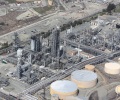

A sustained rally in the Henry Hub winter gas market has lost its momentum in recent trading as the US storage deficit stabilizes and bearish weather forecasts for the upcoming heating season take shape.
Over the past two weeks, forwards prices for the peak-winter months of December, January and February have dipped about 20 to 21 cents, settling Aug. 23 at $4.13, $4.18 and $4.11/MMBtu, respectively, S&P Global Platts’ most recently published M2MS data shows.
In Aug. 24 trading, NYMEX futures contracts for the same peak heating demand months were down about 2 cents from the prior-day settlements, data from CME Group showed.
While winter 2021-22 gas prices remain elevated by historical standards, the more-than-four-month rally in the forward market appears to have lost steam recently after a series of storage reports released by the US Energy Information Administration showed this season’s deficit beginning to narrow. With the winter months now fast approaching, rising market confidence in bearish, long-range weather forecasts has further dampened the bullish sentiment in the forward and futures gas markets.
Storage
Since the start of April, a growing US gas storage deficit helped fuel a rally in winter gas prices.
After beginning injection season with stocks around 1.85 Tcf – a modest surplus to the five-year average – the pace of injections quickly cooled, dropping inventories to 190 Bcf below average by early July.
Recently, a series of larger-than-average injections has helped to narrow the deficit to 174 Bcf with winter inventories now estimated at 2.822 Tcf for the reporting week ending Aug. 13, EIA data shows.
There’s good reason to believe that this season’s inventory deficit will continue shrinking through the approaching autumn months, according to S&P Global Platts Analytics.
This summer, strong gas-fired power burns have diverted considerable supply away from storage with generator demand remaining largely unresponsive to mid-$3 and now even $4 gas prices. While limited thermal capacity in the generation stack has limited fuel switching until now, cooler temperatures in September and October should give power generators more optionality to burn coal instead of gas.
According to Platts Analytics, the shifting trend should allow for more gas to be diverted to storage.
Weather
Further dampening bullishness for this winter’s gas market, the US National Weather Service last week released its latest outlook for December, January and February, predicting a 30%-40% chance for above-average temperatures in states stretching from Maine to Florida, across the entire Southeast and Texas, as well as the Desert Southwest.
Most notable is the risk to temperatures in the Northeast. A key heating demand region for the gas market, states along the Northeast Atlantic Seaboard typically account for over one-third of total US residential-commercial gas demand during the winter months.
Over the past three winters, heating demand in the Northeast from November to March has trended as high as 15.4 Bcf/d during the coldest winter to as low as 13.4 Bcf/d during the mildest winter. Normal weather this winter would see regional res-comm average close to the midpoint of the two extremes, Platts Analytics data shows.
Source: Platts